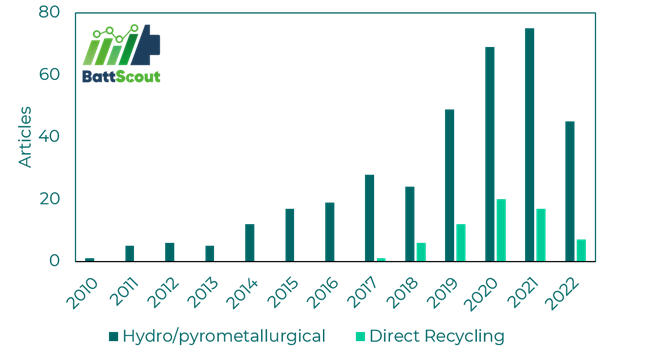
Approaches to Lithium-Ion Battery Recycling Methods
Due to the fast growth of the electric vehicles market, lithium-ion battery production is also rapidly developing as it will reach 6 TWh by 2030. It is expected that the mining industry cannot grow as fast as the battery industry demands. On the other hand, many used batteries need to be recycled as an ecological issue, so recycling seems inevitable. This article covers a variety of recycling methods for spent lithium batteries.
There are three primary recycling procedures for lithium-ion batteries: Pyrometallurgy, Hydrometallurgy, and direct recycling. The common precursor of these methods is a shredded mixture called “Black Mas.” The first method, pyrometallurgy, is based on the high-temperature treatment and roasting of black mass that leads to evaporating the volatile organic electrolytes and decomposing the binder. In the presence of reducing metals such as aluminum, an alloy of nickel, cobalt, copper, and iron is formed, which is used to extract raw battery materials. A slag is formed as a byproduct of the metal alloy containing lithium, aluminum, and manganese which can be separated through a hydrometallurgical process. The second method, Hydrometallurgical reclamation, involves using a leaching agent, usually sulfuric acid and hydrogen peroxide, to turn metal oxides into sulfates. The metals may be recovered by manipulating the solution parameters such as pH. Lithium is generally extracted as a carbonate or phosphate salts (LiCO3 or LiPO4), and other metals like cobalt or nickel precipitate as sulfate, oxalate, hydroxide, or carbonate salts.
The latest method of recycling Li-ion batteries is direct recycling or “upcycling.” This process consists of two steps, removing active material from the electrode and a lithiation process. As lithium in cathode material reduces over many charge/discharge cycles, a relithiation process can make it reusable. Direct recycling is an affordable process as it does not require decomposing active material of spent batteries to synthesize new material.
According to figure 1, the patenting of recycling technologies has generally experienced a significant increase in recent years, especially since the first two methods are more prevalent in patenting than the direct recycling technique.

Figure 1, Timeline of recycling patents based on methods
As seen in figure 2, the top institutes in hydrometallurgy recycling methods are Central University, the Chinese Academy of Science, and the Beijing Institute of Technology, followed by Aalto University in Finland. Aalto University has developed an ecosystem of battery metals called “BATCircle”.It aims to provide raw materials for lithium-ion batteries by recycling spent batteries. This project started in 2019 and will have finished by 2024 with 19 Million Euros in funding and the collaboration of 15 companies.
In contrast to mentioned organizations, United States institutes mainly use direct recycling methods. Argonne National Laboratory, Virginia Tech University, University of California-San Diego, and Oak Ridge National Laboratory are top institutes in direct recycling. These institutes have established the ReCell Center, which aims to develop the recycling of Li-ion Batteries in the U.S. This center focuses on four main areas: direct cathode material recycling, modeling and analysis, recycling of anode and lithium, and designing new cells to facilitate the reusing of lithium-ion battery materials. U.S. Department of Energy Started investing in battery recycling in 2011 with 17 projects. In addition, Farasis Energy and OnTo Technology research institutes completed their direct recycling projects during 2017-2021 and 2014-2016 with initial funding of 1.8 M$ and 1M$ respectively.

Figure 2, top institutes in lithium batteries recycling
Finally, the previous articles of BattScout , Patent Analysis of RecyclingTechnologies provides an additional insight about battery recycling.

